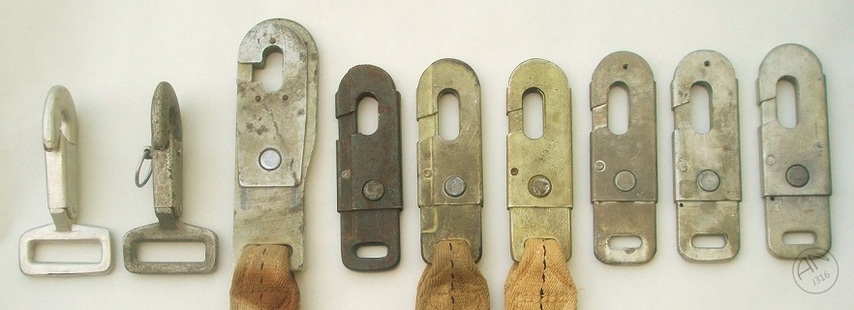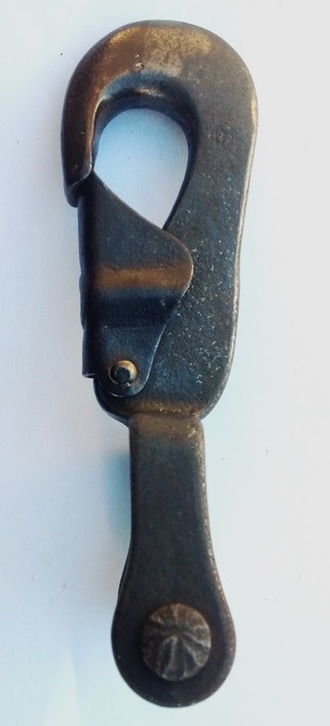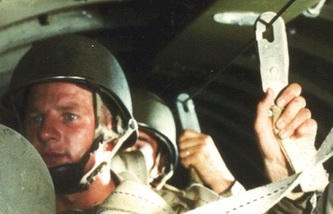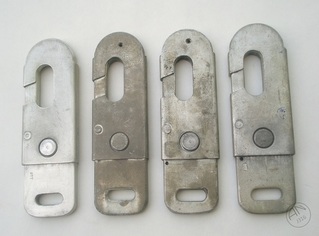"HOOK UP!" - Evolution of WWII Static Line Hooks
|
#0: Lineman's Hook
The early T-4 static line hooks were a stopgap measure until one for this specific application could be developed. Known as a lineman’s pole snap, it was originally designed to help secure technicians while climbing electrical poles. This hook has several slight variations and stands at just over 5 inches tall. At approximately 10.5 ounces, this heavy hook was made from blackened steel with the wide characteristic roller over which the webbing passed. This hook was rapidly replaced by the new 41B3674. #1 & 2: Hook 41B3674 The T-4 and early T-5 parachutes employed the simple spring-loaded 8.5-ounce 41B3674 snap hook. In late 1941/early 1942 a safety pin was added. Motion picture photography revealed that during the jump sequence the snap hooks rebounded off each other and could unhook, releasing the jumper. The result was pin, Part No. 42A3519, which screwed into the gate and firmly locked the gate closed after being snapped onto the anchor cable. The pin was attached to the snap hook by a short length of cord. #3: Hook 42B3232 In February 1942 snap hook 42B3232 was introduced and would become the most common fastener on the white training style T-5s. This mammoth hook, weighing in at just over a pound and measuring approximately 6.5” long, was the first in a long line of sliding-gate fasteners which are still in use today. The main improvement was the vertical sliding gate, which was locked by a spring-loaded push button. This type could not accidentally unhook, as it required the deliberate actions of the user to depress the button and simultaneously slide the gate downward. A total of 9 parts were required to make this unwieldy beast, leading to the development of the simpler 43A9502 hook . #4: Hook 43A9502 The last days of 1942 ushered in the 1,500 lb T.S. 43A9502 snap hook. Although it retained the characteristic sliding gate mechanism, the new hook weighed 8.5 ounces - only one-half of its predecessor. In addition, the length was reduced to about 5", compared to the 6.5" length of 42B3232. This snap can easily be identified by its truncated front edge running nearly the full length of the hook. Many of the early batches were parkarized to match the newly introduced camouflage assemblies, but this was soon switched to the standard cadmium. However, both types soldiered on until the end of the war. Snap fastener 43A9502 was the most widely used static line hook of the war. #5: Late WWII Version In December 1944, the specification for snap hook 43A9502 was further simplified. The result was a slab-sided hook which was slightly thinner and lacked the truncated front edge, but otherwise identical to the original version. This model appeared late in WWII and saw only limited action before the end of the war. This was standard issue for the quick release T-7 parachute. Postwar Versions In 1947, an additional safety feature was incorporated into snap hook 43A9502. A hole through which a safety pin could be inserted was drilled on the upper portion of the hook through both the sliding gate and frame. With the pin in place, it was impossible to retract the gate and release the hook from the anchor cable. Later, the safety pin hole was moved under the gate, and some transitional variations even have both holes. Circa 1960s, the drawing number switched to MS70120, which still has certain applications today. |












